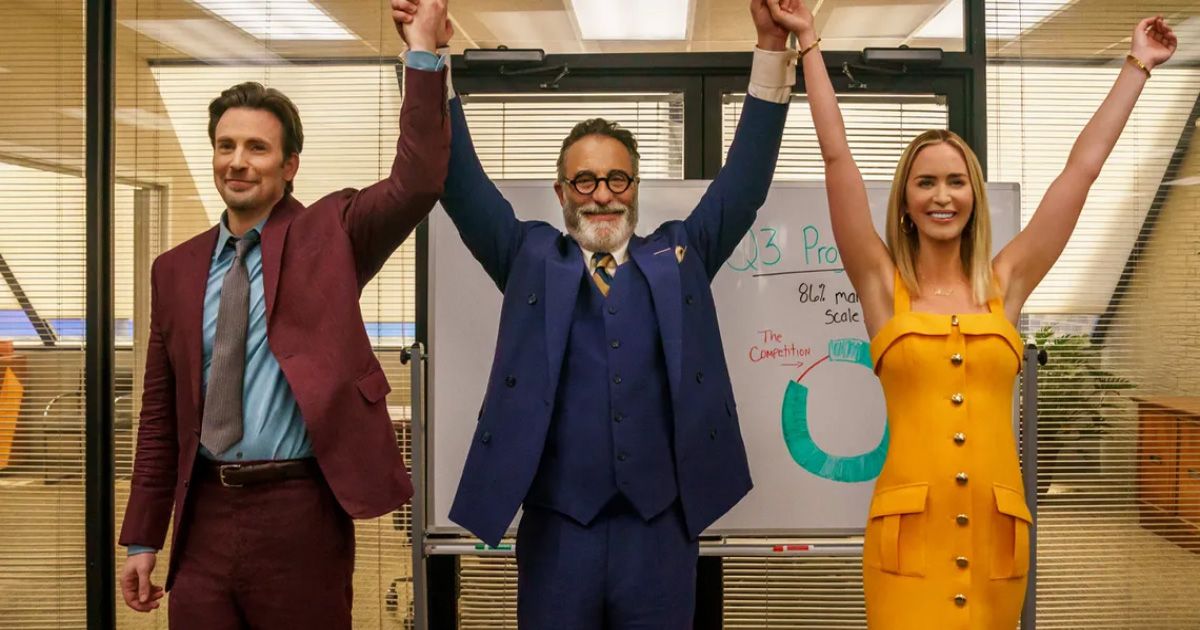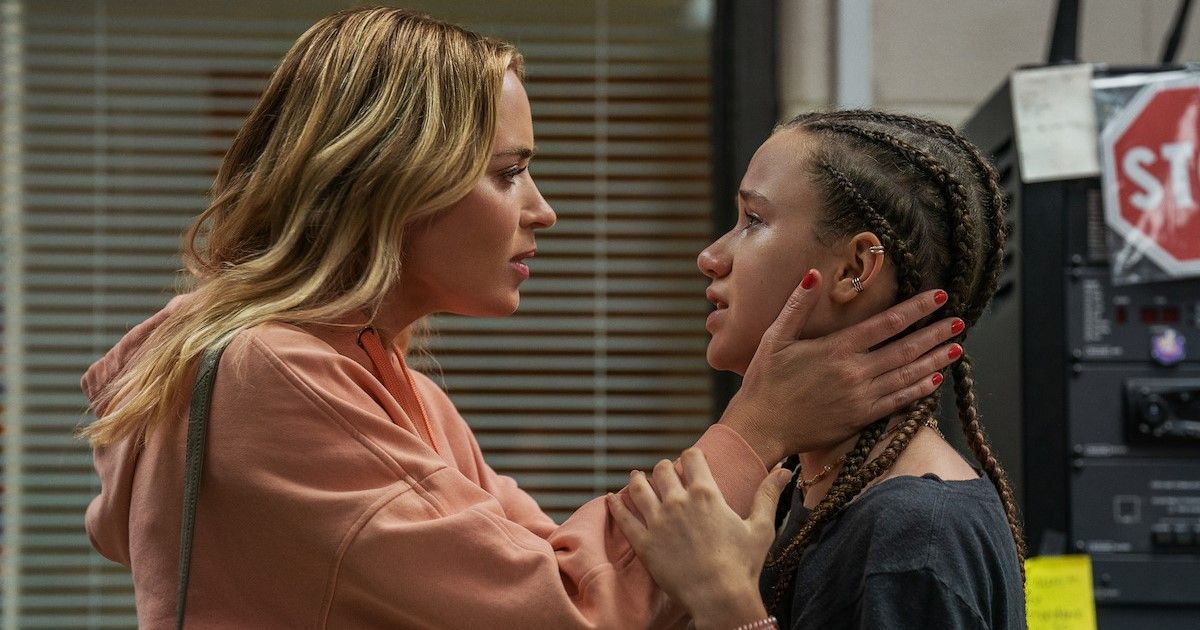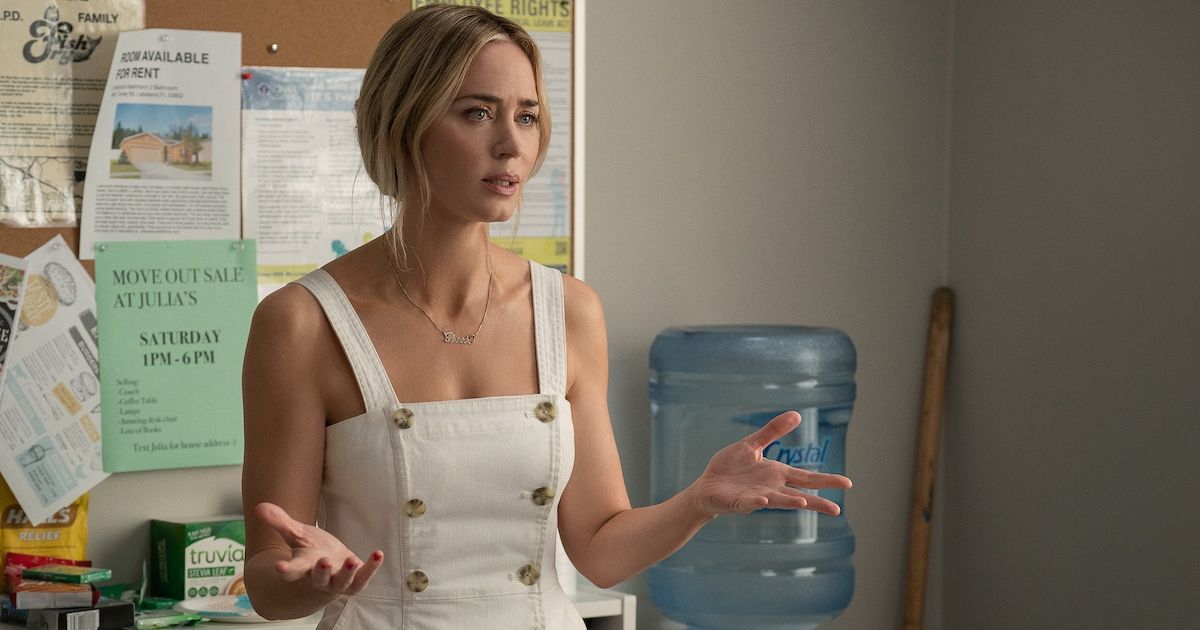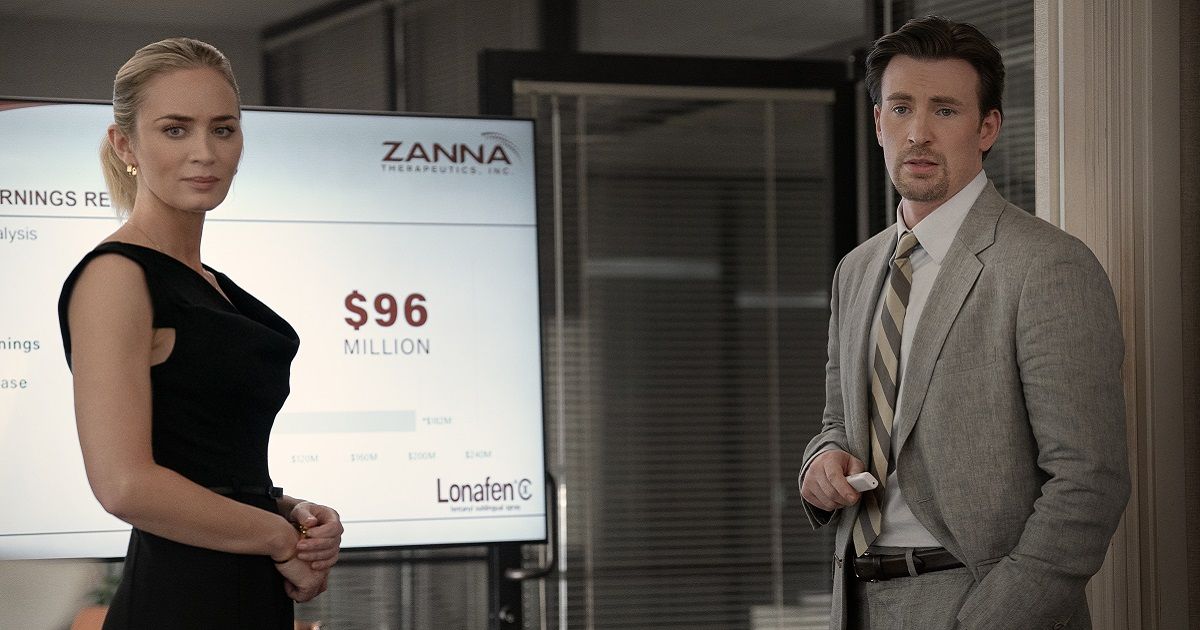Pain Hustlers has all the makings of a “big deal movie.” It is director David Yates‘ second non-Wizarding World feature since he entered the franchise in 2007 with Harry Potter and the Order of the Phoenix (the other was 2016’s The Legend of Tarzan). It features big stars like Emily Blunt, Chris Evans, Catherine O’Hara, and Andy Garcia, and it tackles a very important topic like the opioid crisis in a big splashy film that looks like a lot of your favorites… and that might be the biggest problem. It constantly reminds you of better movies you’ve seen before and does not feel like the best use of anyone’s involved time.
Directed by Yates and based on the book The Hard Sell by Evan Hughes from a script by Wells Tower, Pain Hustlers tells the story of Liza Drake (Blunt), a high school dropout who lands a job with a failing pharmaceutical start-up, Zanna, in Central Florida after being recruited by Pete Brener (Evans). Drake and Brener take the company by storm by pushing a new pain medication for cancer patients. She rises through the ranks of the company by bringing on an army of beautiful men and women to get doctors to prescribe these new drugs. Yet eventually, it all comes crashing down thanks to conspiracies, double dealings, and unethical choices.
Stop Me if You’ve Heard This One
If Pain Hustlers sounds like many other movies you’ve likely seen before, that is because it is. Pain Hustlers tries to be to the opioid epidemic what The Big Short was to the 2008 recession, and tries to explore the comedic party attitude that leads to destruction as in The Wolf of Wall Street, but when you read that out loud, you realize the problem. Those two films mixed comedy and drama to highlight how absurd it all was while also showcasing that while some people were living foolishly and splurging in the worst way possible, others suffered. Pain Hustlers isn’t quite funny, making the entire procedure seem glib. It also makes the dramatic moments feel sudden and abrupt.
The opioid epidemic is a little harder to pin down than the 2008 Housing Crisis. There is not one single “zero hour” event that triggered it, but more of a long line of events starting in the late 90s. In 2017, of the 70,237 recorded drug overdose deaths, 47,600 involved an opioid. It is a serious issue that has been tackled in a wide array of projects, typically in the form of dramas like Dope Sick.
That is why, on paper, Pain Hustlers sounds like an interesting idea. There is nothing to say one could not take a more satirical and comedic look at the situation with a more upbeat attitude. It wants to tackle it with a sense of seriousness and humor combined, similar to how Trainspoitting tackled drug abuse. Yet the key difference is the subject matter.
Pain Hustlers Has the Wrong Protagonists
In the case of Trainspotting, the focus was on the drug users and showcased it from their point of view. They were still the victims. Pain Hustlers puts the focus not on the millions of Americans who got addicted to opioids from reckless prescriptions but instead on those who pushed for the drugs to be sold — the sales representatives who were just trying to make money. They are the ones who get to be the villains, but also, in Pain Hustlers‘ ‘cake and eat it’ way, the protagonists who get to learn the errors of their ways when the story’s more interesting subjects are those that are trampled on by others’ desire for money.
While you can have an unlikeable protagonist as your lead, instead of going for The Wolf of Wall Street route and committing to the lead character being an abhorrent person, Pain Hustlers decides to make its lead character grow a moral conscience and decide she does not want to do this anymore. Funny enough, it draws a parallel to a film it shares a partial name with, Hustlers, but lacks the style or stand-out performances of that movie, or even an ounce of reality (it even takes Hustlers’ framing device of the movie being a dramatized interview).
While the decision to keep the focus lighthearted and harmless until the mid-point reflects the main character waking up to the reality of the situation, it comes off in poor taste with some unwarranted character growth. This is also confounded by the fact that while the movie is inspired by true events, it is so loosely. It takes the broad concepts of the bribery scheme run by opioid manufacturer Insys Therapeutics and makes characters that are stand-ins and amalgamations for real-life situations and people. This gives the movie less bite and more a collection of thoughts and ideas rather than a story.
Emily Blunt’s Conflicted Characterization
Blunt’s Eliza Drake is the center of the movie and the film’s most complicated element. The movie clearly has empathy for her, as there are many people like her who are struggling to make enough money to support their families. The American Dream is a complicated one and has served as the backdrop to many great films for interrogation. While Drake is certainly not wrong to want more and make sure she and her daughter have enough money to be comfortable, the movie wants audiences to think of how many people suffered because of her.
Yet the movie never actually asks that question, at least not in a meaningful way. It pays lip service, but the film doesn’t highlight her being “seduced” by more wealth. It just is part of the job, one that she thinks she is doing right by, because the drug she sells is supposed to be better for cancer treatment. She stops when she realizes people are dying and is never faced with a true ethical dilemma that tests her character. The movie wants her to be complicit but distances her from the actual issues to make her redemption easier.
That is not to say Emily Blunt isn’t good. The entire cast is good and gives solid performances, from Evans to Andy Garcia and Catherine O’Hara. One of Yates’ unsung talents has always been his ability to get great performances. Certainly, it does not hurt to cast talented performers who can do this in their sleep, but some of the best work from the young Harry Potter cast came under Yates’ direction. Say what you will about the complicated misfires of the Fantastic Beasts films, but the strongest part was always the casting, which he did from the ground up as opposed to coming in as he did with Harry Potter, which already had its central lineup.
It is admirable for Yates to want to try something different, a smaller film that is not a big-budget franchise, one that is closer to the political dramas that he used to make before becoming one of the biggest directors in the world. Yet here he never quite gets into the deep character work that defined his early career, like with the miniseries State of Play or Sex Traffic, and he feels at odds with the material.
Part of that could be his British nationality. Unlike the United States, the United Kingdom and various other parts of the world have government-sponsored universal healthcare systems. They do not have to explicitly pay for healthcare like Americans do, so the idea of doctors being bribed and money being made off pharmaceuticals must sound absurd, so that partially explains the slightly more energetic comedic tone here. If anything, that provides a more interesting conversation about the difference between the two healthcare systems informing the material than the actual movie itself.
Pain Hustlers Isn’t Actively Bad, Just Forgettable
Pain Hustlers is not a bad movie. It has too many good actors giving solid performances and decent direction to be bad. Yet, it is forgettable. Like many Netflix Originals, it is designed to be half-watched and then forgotten about. Despite the best intentions of all the talent involved, it bears the burden of Netflix’s stigma. It feels like a movie greenlit because Netflix’s algorithm told them that movies like The Wolf of Wall Street, The Big Short, and Hustlers were big on the streaming service. Ultimately, it just reminds you of those films, and that you could be watching something better.
Pain Hustlers is currently streaming on Netflix.
This story originally appeared on Movieweb




